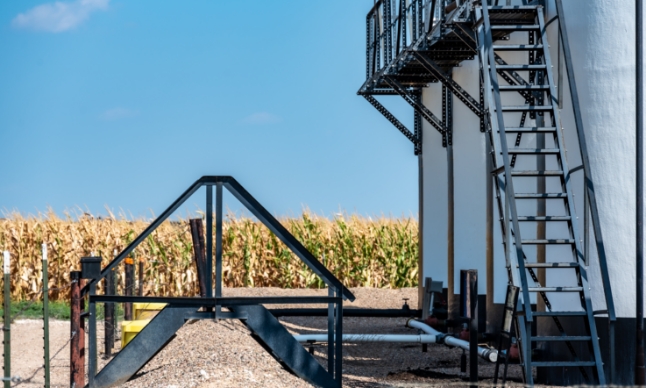Call Us: 1.800.275.3453
Request a QuoteCall Us: 1.800.275.3453
Request a Quote
Having secondary containment in place is mandatory, but if it’s inadequate to handle a hazardous spill, you could unwittingly contaminate water supplies and cause environmental havoc. Our Secondary Containment Calculator takes the guesswork out of choosing the right size spill containment berm to safeguard your site and prevent disaster. By following a few steps, you can be sure you’re fully prepared for any scenario.
In this article, we’ll explore the benefits of using a berm calculator. We’ll walk you through the process step-by-step, from entering the necessary parameters to interpreting the results for optimal spill prevention.
Whether you want to enhance existing containment systems or design new installations, this guide offers insights and advice to help you achieve the precise secondary containment capacity needed to safeguard your facilities and the environment.
Table of Contents

Secondary containment systems are essential for preventing environmental contamination and ensuring regulatory compliance. These systems capture spills from primary containment units, such as tanks and drums, and prevent hazardous substances from escaping into the environment. Accurately determining the required containment capacity is crucial for several reasons.
Regulations like the SPCC (Spill Prevention, Control, and Countermeasure) require facilities to have adequate secondary containment systems in place. The SPCC rules, enforced by the Environmental Protection Agency (EPA), mandate that facilities storing large quantities of oil or other hazardous substances must have a plan that includes sufficient secondary containment to manage potential spills. Failure to comply with secondary spill containment requirements can result in fines and legal repercussions, underscoring the need for precise capacity calculations.
Proper containment prevents spills from reaching soil, groundwater, and surface water, thereby protecting ecosystems. Contaminants can devastate local wildlife, plant life, and water quality. By ensuring that secondary containment systems are adequately sized, facilities can prevent environmental damage and contribute to the planet’s overall health. Organizations like the U.S. Environmental Protection Agency (EPA) and international standards such as ISO 14001 emphasize the importance of environmental management systems, which include effective spill response and containment measures.
Adequate containment reduces the risk of accidents and improves overall safety in industrial settings. Properly sized containment systems ensure that in the event of a spill, hazardous substances are contained and managed effectively, minimizing the risk of fire, explosion, and exposure to toxic materials. This protects the health and safety of employees and reduces the likelihood of costly operational disruptions. By adhering to OSHA (Occupational Safety and Health Administration) guidelines and industry best practices, facilities can maintain a safer working environment.
A secondary containment calculator is a specialized tool for determining the volume capacity required for secondary containment systems, such as berms and containment walls. These calculators consider various parameters, including the volume of the primary containment units and additional factors like rainfall or fire suppression water.
Below are the steps involved in using our berm containment calculator.
Before using the calculator, you’ll need to know the volume of the primary containment unit (e.g., tank or drum) and the dimensions of the containment area.
Input the gathered information into the calculator:
The calculator will process the entered parameters and provide the required containment capacity.
A secondary containment calculator helps you determine the volume capacity required for secondary containment systems, such as berms and containment walls. These calculators consider various parameters, including the volume of the primary containment units and additional factors like rainfall or fire suppression water.
Follow these steps to determine what type of secondary containment system is required for your job site:
Pro Tip: Containment areas with multiple tanks must account for displacement to ensure the proper containment volume is determined. For example, if you have two tanks in the same containment area, you must subtract the volume the second tank would take up in the containment area from the total containment volume to get the final containment figure.
Here’s an example to give you an idea of how this works. Let’s say you’ve got an oil refinery and you need secondary containment big enough to manage the truck’s contents if there’s a spill. Here’s how you calculate the berm size:
Once you know what’s required, it’s time to determine if your current containment system is adequate or if modifications are needed. Polystar Containment has several products that can bring your facility into compliance:
See how simple and fast the installation of a secondary containment pad can be.
Below, we’ve answered a few questions about using our Secondary Containment Calculator. Please contact us for more information.
Freeboard volume is an additional volume added to the containment capacity to account for potential surges, such as those caused by rainfall or fire suppression activities. It ensures that the containment system can handle unexpected increases in volume.
Secondary containment systems are used in various industries, including:
You will need to input the volume of the primary containment unit (e.g., tank or drum), dimensions of the containment area, and any additional factors, such as potential rainfall or fire suppression water.
Using a secondary containment calculator is a vital step in ensuring that your spill prevention measures are effective and compliant with regulations. By accurately determining the required containment capacity, you can protect your facilities, personnel, and the environment from hazardous spills. Polystar Containment offers secondary containment solutions to meet your specific needs, ensuring robust and reliable spill management. Explore our products and leverage our expertise to achieve optimal containment solutions.
contact us